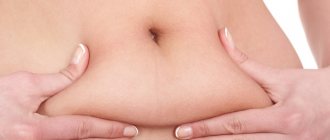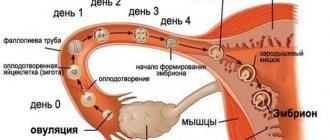Exercises on a chair for losing weight on the stomach and sides, at work: photos, videos
Simple exercises on a chair will replace a full-fledged workout for weight loss! They will help you quickly tone your body and get rid of excess fat. And suitable for people with any level of physical fitness.
Benefits of chair exercises
You can perform these exercises wherever it is convenient for you - at home in front of the TV or at work. To carry out the training, you only need a hard chair or stool and a stable surface for it. Save our collections of exercises and train even in the office - just sitting at your computer desk!
By regularly doing this short seated workout, you can tighten your stomach and make it flatter, work your sides, and even tone your thighs and buttocks. And this in just 10-15 minutes a day! In addition, such a set of exercises will give you strength and energize you.
Important! During exercises, always keep your back straight and never round it. Otherwise, you will overload the work of the lower back, which may cause pain in this area. Leaning on the back of a chair is also prohibited.
Interesting: Exercises with a towel roller for the back
Set of exercises No. 1
This universal training complex is suitable for both women and men. The presented exercises on a chair for weight loss are supplemented with videos and photos - to make it easier for you to follow the correct technique. It is not necessary to warm up before training. The first exercises will perfectly warm up your muscles without this.
- Knee pull-up. Sit on the edge of a chair with your back straight. Bend your knees onto a supporting surface and place them shoulder-width apart. Pull your right leg as far as possible towards your stomach, so that your knee touches your chest. You can use your arms a little to pull your knee toward your chest. Return to the starting position and repeat the pull-up with the other leg. Number of repetitions: 25 times.
- Pull up both legs. Now, sitting on a chair, bring your feet together. Use your palms to hold the edge of the chair or its arms. Pull both legs towards your stomach at the same time, trying to do this using your abdominal muscles. When your knees touch your chest, you can lower your legs. But do not place them on the floor, but keep them suspended. Do the exercise 15 times and only then lower your feet to the floor.
Pull up both legs
- Side twists. Bring your feet together and rest your hands on the edge of the chair. Lean your upper body to the right so that your weight is transferred to your right hip. Now pull the knees of both legs towards your chest. Now lower your feet to the floor and take the starting position. Repeat the same movement on the left side. The exercise perfectly works the waist and sides. Number of repetitions: 15 times on both sides.
- Mill in a sitting position. Taking a comfortable position on a chair, spread your legs to the sides and bend them slightly at the knees. Straightened arms extended to the sides. Now bend your torso towards your knees and twist it to the left side. The right hand touches the left foot. Lock in this position for 1-2 seconds and return to the starting position. Repeat the movement in the other direction. Number of repetitions: 15 times on both sides.
Mill in a sitting position
- Pulling the leg towards the elbow. Sit on a chair, feet shoulder-width apart, hands clasped behind your head. Synchronously raise your knee up and, tilting your torso forward, try to reach it with the edge of the opposite elbow. When your knee and elbow touch, straighten up and return to your starting position. Number of repetitions: 15 times, first on one side, then the same on the other.
- Circular rotations with knees. Sitting on a chair, grab its edge with your palms. Bend your legs at the knees and bring them to your chest. Perform 10 leg rotations, moving clockwise. In this case, the feet do not fall to the floor. Relax. Then repeat the rotation, moving counterclockwise.
Interesting: Exercises with an elastic band for women at home
Selection of exercises No. 2
An additional set of chair exercises that will add variety to your workouts. You can do the workouts one by one or choose the one you like and do only that one.
- Vacuum sitting. This is a very effective and simple exercise that helps to get a flat stomach. Sit on a chair. Place your palms on your stomach and place your feet on your toes. Take a deep breath and exhale and then pull your stomach in as much as possible - as if you are trying to pull it towards your spine. Stay in this position for 5-7 seconds. Then relax your stomach and take a deep breath in and out again. Repeat the exercise 10 times.
- Torso rotations. Sit on a chair with your knees bent. Close your hands at the back of your head. Inhale deeply and exhale as you twist your upper body to the left. As you inhale, return to the starting position and perform the same movement to the right side. The hips are clearly fixed on the chair. Only the upper body rotates and the waist twists slightly. Number of repetitions: 12 times on both sides.
- Imitation of scissors. Sit on the very edge of the chair. Hold the sides with your hands. Straighten your legs in front of you, pointing your toes up. Alternately lift your right and left legs, bringing them parallel to the floor. The abdominal muscles should be tense. Complete 18 reps.
Imitation of scissors
- Bend forward. Sit on the edge of a chair with your hands behind your head. Slowly bend your upper body forward. Hips don't move. Hold at the bottom for a couple of seconds and return to the starting position. Complete 15 reps. Be sure to keep the pace slow, otherwise the exercise will not be effective.
- Static abdominal exercise. Sit up straight with your legs straight. Arms extended forward. Then bend your legs and bring them towards your chest. You need to hold this position for 20-30 seconds. Keep your back straight. The abs should be tense all the time.
As you can see, in order to stay in good shape, you don’t have to torture yourself in the gym. The main thing is not to be lazy and watch your figure! Chair exercises are a great workout for losing belly fat and sides that will take you a minimum of time. Perform it daily and the result will please you very soon!
Source: https://topbodies.ru/uprazhneniya-na-stule-pohudeniye/
Another reason that prevents you from getting a flat stomach
Women very often complain that even serious sports activities do not help cope with a sagging belly and extra pounds around the waist. This problem is especially relevant for women who have given birth to a child. There are so many people upset by this fact that you involuntarily think about the reasons. What is this - banal laziness or a serious health problem? Do a diastasis test and everything will fall into place! And this material will help you understand the essence of this disease and cope with it!
Why does the fat layer around the waist not go away, despite all the known ways to combat it? What is also most frightening is the fact that impact physical activity on the abdominal area leads to an even greater increase in the tummy. If you are familiar with these metamorphoses, then you urgently need to test for diastasis. Diastasis of the rectus abdominis muscles is the separation of their connective tissues. It most often appears after pregnancy and childbirth, but can also be a hereditary predisposition or occur due to the fact that the abdominal muscles are weak and untrained. It is not difficult to diagnose diastasis of the rectus abdominis muscles. To do this, take a horizontal position, bend your knees, place your feet on the floor. Now lift your head and shoulders off the floor. Lock this position. Feel the depression under your navel with the fingers of one hand. If it is small (up to 5 cm), then you have no reason to worry. If the muscle discrepancy feels 5-10 cm wide, then you have severe diastasis of the rectus abdominal muscles and you urgently need specialist advice.
Diagnosis of diastasis of the rectus abdominis muscles

In addition to the above test, back pain, a protruding navel and belly, as during pregnancy, will indirectly tell you about diastasis. If you discover diastasis, the first thing you should do is stop practicing classic abdominal exercises: straight leg raises from a lying position, raising your shoulders and body from a lying position, push-ups and other exercises resting on your palms and elbows.
Exercises contraindicated for diastasis of the rectus abdominis muscles
All of the above exercises will not only not help get rid of a flabby belly, but will also further increase the diastasis of the abdominal muscles and lead to the growth of fat deposits at the waist. But you can’t leave everything as it is either. Ignoring diastasis can lead to hernias, digestive disorders, prolapse of internal organs and problems with posture. Diastasis can also cause birth trauma in your unborn child. How to be? There is an exit. It is necessary to strengthen the abdominal corset with the help of special exercises that are based solely on retracting the abdomen. In this sense, even simple retractions of the abdominal muscles, alternating with their relaxation, are effective. This simple exercise can be performed in any position (sitting, standing, lying down) 100 times in a row. It is necessary to breathe evenly while performing this exercise. The number of approaches per day should be gradually increased to 5. Also, with diastasis, the so-called “Cat” exercise is very effective. To perform it, kneel down and rest on your palms. Alternate arching your back outward with arching inward. At the same time, pull your stomach tightly into yourself. Repeat each bend at least 10 times.
Exercise "Cat"
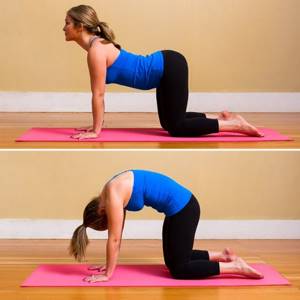
To perform the next exercise, lie on your back, bend your knees, place your feet on the floor, and place your arms along your body. On the count of “one,” lift your buttocks off the floor, pull your stomach in, and tuck your buttocks. On the count of two, return to the starting position. During this exercise, both the abs and gluteal muscles work simultaneously. Repeat the exercise at least 10 times.
Exercise “Lifting the buttocks”
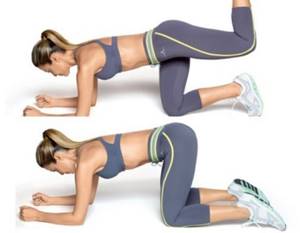
From the same starting position, perform 10-20 head lifts while simultaneously drawing in your abdomen. Make sure that your shoulders do not come off the floor and your stomach is constantly drawn in. All movements should be smooth, without jerking.
Exercise "Head lift"
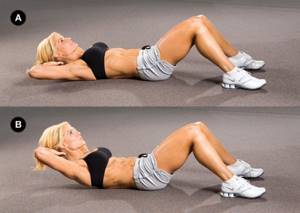
From a supine position, lift your knees bent so that your thighs are perpendicular and your shins are parallel to the floor. Now slowly lower one leg to the floor and, sliding your heel along the floor, straighten your leg. Slowly return to the starting position. Make sure your stomach is constantly pulled in. Do the same exercise with the other leg. Alternate your legs. Do at least 10 repetitions on each leg.
Finally, do a lower back stretch. From a lying position on your back, turn your head in one direction and your legs bent at the knees in the other. Hold this position for a couple of seconds. Then turn your head in the opposite direction and, accordingly, turn your knees to the other side. Repeat the exercise at least 10 times in each direction. Constantly monitor the tummy tuck.
Exercise “Lumbar Stretch”
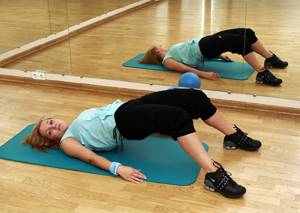
Perform these exercises daily, and in a couple of months the diastasis will recede!
If you liked the article, save it and share with your friends!
Why should it be considered normal for folds on the stomach when sitting?
Anna Victoria, a Fit Body Guide trainer, wrote a manifesto post on her Instagram about why your stomach shouldn't be completely flat. According to her, he doesn’t owe anyone anything at all, just like you.

© instagram
“I decided to share this photo with you for two reasons. First, I want you to know that there is nothing to be ashamed of when you sit and have folds on your stomach, and it is certainly not a reason to hate yourself. Secondly, there were also times in my life when, sitting in front of the mirror, I unconsciously thought, “ugh.” It’s worth saying that society has created all the conditions for me to think so,” writes Anna.
The girl writes that our stomach does not have to be perfectly flat for us to be healthy. It doesn’t have to be perfect for us to love ourselves, to be confident, beautiful and wonderful people.
“We, as part of this society, should not allow physical characteristics to set some standard that will determine whether we deserve self-love or not. Every person deserves his own love. Although I understand perfectly well that it is always easier said than done,” the girl continues.

© instagram
According to her, she is sincerely surprised when she watches girls doing the Fit Body Guide program. For the most part, they begin to love themselves not so much in the wake of changes occurring in their body, but as a result of psychological and emotional changes. These variables are the result of absolute dedication, overcoming and understanding how powerful they really can be. They are as important in the mind as physical progress (if not even more important). True strength and beauty can only be felt and seen within ourselves.
Pain emanating from the digestive organs
Pain in the lower abdomen in both women and men can occur due to intestinal dysfunction. On the right is the projection of the appendix, the ileocecal angle, formed by the connection of the jejunum and cecum.
This is where an appendix called the vermiform appendix emerges. The wide and short cecum descends below the crest of the iliac pelvic bone. The skinny one is close to her from behind. The left iliac region contains the sigmoid and rectum portions of the large intestine.
Attack of appendicitis
Appendicitis is a paroxysmal inflammatory disease with local damage to the appendix. In a chronic course, it spreads to neighboring areas of the intestine and the adjacent part of the peritoneum.
The disease can be caused by:
- chronic digestive disorders with stagnation inside the appendix;
- adhesive changes in the abdominal cavity, adhesions with other organs;
- intestinal atony with prolonged constipation;
- specific effect of infection in typhoid fever, tuberculosis;
- abdominal trauma;
- obstruction of patency in case of eating nuts and seed husks;
- abnormal structure.
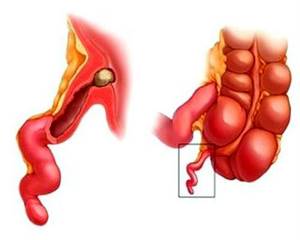
The exit from the appendix may become clogged with fecal stones
The classic picture begins with pain in the stomach, fever, and vomiting. Reminds me of food poisoning. After 2–3 hours, the pain “descends” to the right iliac region and intensifies to a pronounced attack. Possible irradiation from bottom to top in the right hypochondrium, in the navel, lower back, anus.
Normally, the appendix has a different position, which makes diagnosis difficult. An upward deviation is characteristic of an attack in a pregnant woman. Usually, against the background of pain, there is local tenderness on palpation and tension in the abdominal muscles. Abnormal bowel movements (diarrhea or constipation).
If the pain becomes throbbing, “twitching”, then a suppurative process (phlegmonous or gangrenous appendicitis) should be expected. There are situations with moderate dull pain that women endure without seeking medical help.
The disease does not disappear, but becomes chronic. A restrictive “bag” of adhesions is formed around the process. It delays the formation of diffuse peritonitis. The pain recurs with varying intensity. Treatment is only surgical.
Crohn's disease
The disease has no exact cause. Pathological changes are expressed in the form of areas of granulomatous (lumpy) inflammation, alternating with normal intestinal tissue. The cecum region is the most common location.
Inflammation is characterized by through damage to the wall, the formation of rough cracks, ulcers, fistulous tracts between organs, cicatricial and suppurative processes. The disease lasts a long time with relapses even after 20 years.
A predisposition to the disease in women has been established:
- with a burdened family history (immediate relatives are sick);
- long-term “experience” of smoking and alcoholism;
- low immunity as a result of chronic infectious diseases.
Severe cramping pain in the lower abdomen on the right with ileitis indicates an active process. They intensify after eating or excitement. They may have a permanent bursting character. In addition, patients are concerned about:
- bloating;
- frequent loose stools (possibly mixed with pus and blood);
- nausea and vomiting;
- poor appetite, weight loss;
- low temperature;
- weakness.
Timely detection and treatment can achieve long-term remission.
Nonspecific ulcerative colitis
The disease begins in the rectum and “rises” further through the large intestine. The nature of the inflammation remains unclear. Ulceration of the mucous membrane does not extend to the deep layers of the wall. Women with low immunity, long-term use of toxic medications, and unfavorable heredity are more often affected.
Main features:
- cramping pain in the left iliac region and side, aggravated by eating, defecation, and physical activity;
- tendency to diarrhea;
- impurities of pus, mucus and blood in the stool;
- moderate increase in temperature;
- weight loss, weakness.
The most common complication is intestinal bleeding. In therapy, strong anti-inflammatory drugs and hormones are used. Surgery may be needed in an emergency.
Diverticulosis
The disease is caused by a disturbed structure of the intestinal wall. The cause of nagging pain in the lower abdomen is inflamed saccular protrusions. They are formed:
- in elderly women with atony and a tendency to constipation;
- with a lack of water and fiber intake;
- in overweight people with low physical activity;
- in case of anomalies in the development of the intestinal wall;
- with a pronounced atherosclerotic process in the arteries of the abdominal cavity with intestinal atrophy.
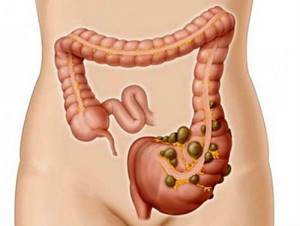
The most common location of diverticula is the sigmoid colon
Diverticula can cause intermittent aching pain in the area of projection onto the abdominal wall. Severe spasms occur when these formations become inflamed and twisted, causing partial intestinal obstruction to form. Therapy includes intensive anti-inflammatory drugs. If there is a threat of peritonitis and obstruction, surgery is performed to remove diverticula.
Colon cancer
Adenocarcinoma most often affects the sigmoid and rectum, so differential diagnosis is carried out when it is unclear why the lower abdomen hurts in women in the left iliac region. Cancer can be detected at an early stage only by indirect signs, since it does not cause severe pain.
